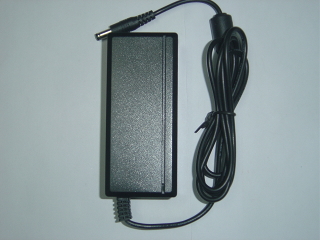Now released for well over a year, here is an in-depth review of the AzBox miniMe American Edition which is an advanced HD FTA satellite receiver specifically designed for FTA satellite hobbyists, enthusiasts or feed hunters in mind. It is the only current AzBox model in the North American market and has full hardware 4.2.2 support which has been a long key selling feature for AzBox HD satellite receivers.
The AzBox miniMe features a compact but stylish design with a black plastic casing which blends in well with today's modern home theatre equipment. Unlike most set top boxes, the AzBox miniMe features rounded side panels which adds to its flair and elegance. Ventilation holes can be found on the top of the unit to help keep the receiver running cool, even without an internal fan.
 |  |
The front panel features a single button to turn the receiver on or off. The LED light surrounding the power button changes color based on the current operating mode of the receiver. For example, orange indicates the receiver is in standby mode and blue means that it's on. The LED light also flashes when the receiver is busy doing something such as scanning or playing back a recording. The front panel also features the AzBox miniMe logo along with the stylized Z from the AzBox logo and a 1/8" headphone jack for an external IR receiver (not included) if you wish to install your receiver in a location with no clear line of sight for the infrared remote control to function. However, we believe that most people will want to have the miniMe as the centerpiece of their home entertainment system so the external IR receiver should not be required.

 The back panel as shown on the left features a variety of connections including IF input, loop out, Ethernet LAN connection, S/PDIF optical audio output, HDMI output, two USB ports, an e-SATA port, component and composite outputs using the included breakout cables as shown on the right. Although a hard disk can't be installed inside the unit due to its small size, the e-SATA port will ensure high performance for your external hard disk.
The back panel as shown on the left features a variety of connections including IF input, loop out, Ethernet LAN connection, S/PDIF optical audio output, HDMI output, two USB ports, an e-SATA port, component and composite outputs using the included breakout cables as shown on the right. Although a hard disk can't be installed inside the unit due to its small size, the e-SATA port will ensure high performance for your external hard disk.The AZBox miniMe American Edition is powered by a full size external heavy duty 12V DC 3A power supply which comes with the unit similar to one used on a laptop and is specifically designed for the North American electrical standard with the included power cord. However, a separate compact power supply with an integrated European plug is also included should you wish to operate the receiver in a European country. As this power supply is also universal, it also has the added benefit of acting as a backup power supply simply by adding an inexpensive euro to North American plug adapter should the full size external power supply ever fail while waiting for a replacement. This is a unique and welcomed feature as all other FTA satellite receivers to our knowledge only include 1 power supply which means your receiver can't be used until a replacement is received if it ever fails.


As only 12VDC and 2A are required to operate the receiver, it can easily be operated using alternate power sources such as a battery or solar power which makes it ideal for use in mobile environments such as RV's or tailgating. Due to its small size, there is no mechanical on/off power switch on the rear panel but as an external power supply is used, it is easy to simply unplug the power cord from the back of the unit.
Let's now look at the remote control that comes with the AzBox miniMe American Edition which is ergonomically sized so that any button can be easily reached using the average hand's thumb. It features a unique ring of function buttons surrounding the arrow keys and OK button. While you may press one of these function buttons instead of an arrow key at first by mistake, one will quickly get used to sensing where the arrow keys are and avoid making this error in the future.
 | Power button: Allows you to quickly put the receiver on standby or resume using it. Holding down the power button for 5 seconds reboots the receiver. Mute button: Temporarily disables the audio. <- key: Switches back to the previous channel. ^ key: Shows a historical list of the last 10 tuned channels and allows you to switch to any of them. MENU key: Allows the user to access various context sensitive menus. HOME key: Allows the user to access the favorite channels list. INFO key: Allows the user to view information on the currently tuned channel. Arrow and OK keys: Allows the user to select menu options or display the channel list. LANG key: Allows the user to change the current audio channel and volume offset for the current channel. EPG key: Allows the user to view program guide information if available. Vol + - keys: Allows the user to adjust audio volume. Exit key: Allows the user to back or cancel out of the currently displayed menu. Ch ^ v keys: Allows the user to change to the next or previous channel. Color keys: Functionality of these 4 keys is dynamic based on the currently active menu. PVR keys: Used for recording or playback of content. |
